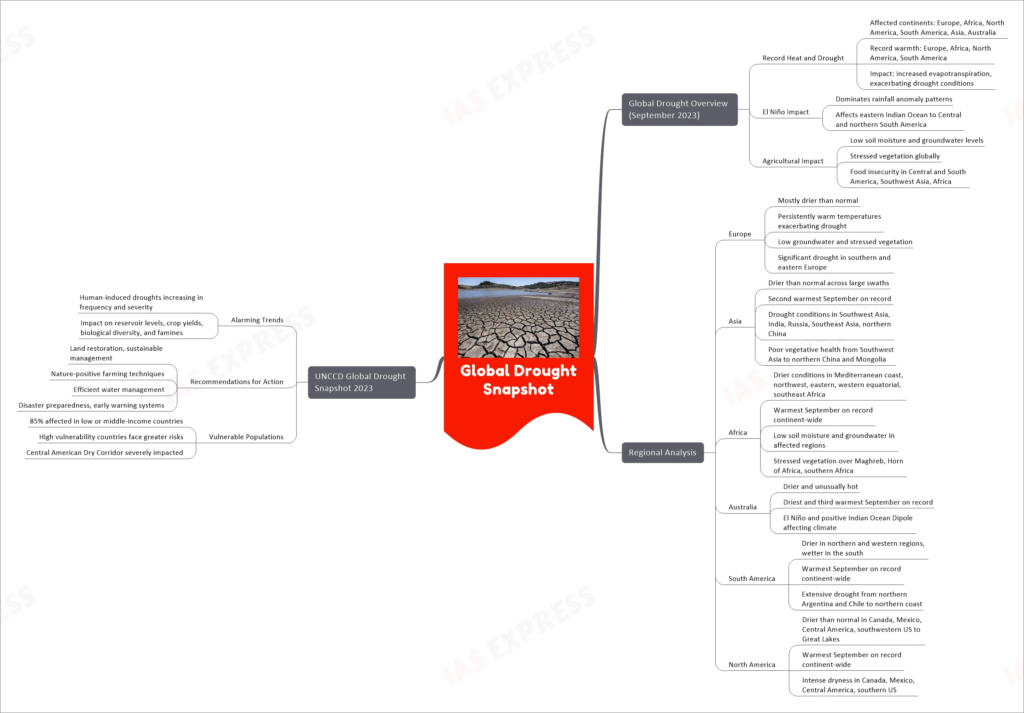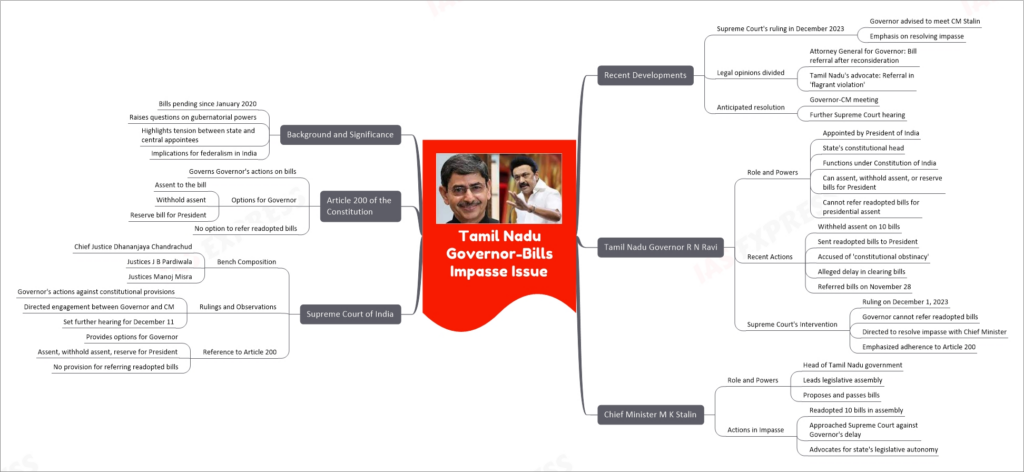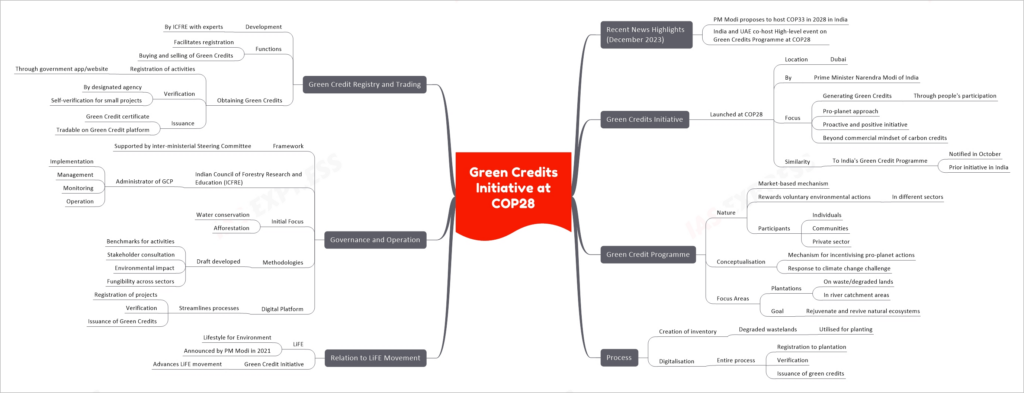[Newsbits] 2.12.2023 – Green Credits, LeadIT 2.0, White Lung Syndrome & more

This topic of “Global Drought Snapshot” is important from the perspective of the UPSC IAS Examination, which falls under General Studies Portion.
Introduction
The global drought situation as of late 2023 presents a critical scenario, with widespread impacts across continents. Record heat and dry conditions have exacerbated droughts, affecting agriculture, water resources, and leading to food insecurity in several regions. The UN Convention to Combat Desertification (UNCCD) emphasizes the urgency of addressing human-induced droughts and the necessity for immediate action.
Global Drought Overview (September 2023)
- Record Heat and Drought
- Continents including Europe, Africa, North America, South America, Asia, and Australia experienced record warmth and dry conditions.
- Increased evapotranspiration, influenced by El Niño, aggravated drought conditions, particularly affecting the eastern Indian Ocean to Central and northern South America.
- Agricultural Impact
- The drought led to low soil moisture and groundwater levels, with global agricultural lands suffering.
- Food insecurity escalated in regions like Central and South America, Southwest Asia, and Africa.
Regional Analysis
- Europe
- Most of the continent experienced drier than normal conditions with persistently warm temperatures.
- Drought conditions were significant in southern and eastern Europe, with low groundwater and stressed vegetation.
- Asia
- Large areas, from western Russia to central Asia and Southwest Asia to parts of China, were drier than normal.
- The continent witnessed the second warmest September on record, with drought conditions plaguing several regions.
- Africa
- Drier conditions prevailed across the Mediterranean coast, northwest, eastern, western equatorial, and southeast Africa.
- The continent recorded the warmest September on record, with low soil moisture and groundwater in affected regions.
- Australia
- Australia experienced its driest and third warmest September on record.
- Climate drivers like El Niño and the positive Indian Ocean Dipole contributed to these conditions.
- South America
- Northern and western regions were drier than normal, while the south experienced wetter conditions.
- The continent faced the warmest September on record, with extensive drought in various areas.
- North America
- Most parts of Canada, Mexico, Central America, and the southwestern U.S. to the Great Lakes were drier than normal.
- The continent also recorded its warmest September on record.
UNCCD Global Drought Snapshot 2023
- Alarming Trends
- The report reveals alarming trends of increasing human-induced droughts with severe impacts on lives and livelihoods.
- It emphasizes the need for transformational change to address the frequency and severity of drought events.
- Recommendations for Action
- Key recommendations include land restoration, sustainable management, nature-positive farming techniques, efficient water management, and investment in disaster preparedness and early warning systems.
- Vulnerable Populations
- The report highlights that 85% of those affected by droughts live in low or middle-income countries.
- The Central American Dry Corridor is particularly impacted, with millions needing food aid.
Conclusion
The global drought situation as of December 2023 is a call for urgent and concerted action. The increase in frequency and severity of droughts, driven by human-induced factors, requires immediate response and long-term strategies. The focus on sustainable practices, disaster preparedness, and resilience building is crucial to mitigate the impacts of drought and safeguard vulnerable communities worldwide.
This topic of “White Lung Syndrome” is important from the perspective of the UPSC IAS Examination, which falls under General Studies Portion.
Introduction
White Lung Syndrome, a type of pneumonia, has been increasingly reported globally, with significant spikes in cases, especially among children. This mysterious illness, marked by respiratory symptoms, has raised concerns due to its rapid spread and the challenges it poses in diagnosis and treatment.
White Lung Syndrome Overview
- Definition
- White Lung Syndrome is characterized as a type of pneumonia that leads to inflammation of the lungs.
- The illness is notably rampant among children.
- Global Spread
- Cases have been reported in various regions including Europe, the US, and China, reaching epidemic levels in Denmark and seeing a notable spike in the Netherlands.
- Characteristics
- Primary victims are children, presenting symptoms such as fever, coughing, and fatigue.
- Some cases also exhibit shortness of breath and the production of phlegm.
- Prevention Measures
- Key preventive measures include regular handwashing, covering the mouth while sneezing or coughing, and avoiding social interaction when sick.
Causative Agent
- Mycoplasma pneumoniae
- The condition is caused by a bacterial infection known as Mycoplasma pneumoniae, particularly common in younger children.
Recent Developments
- Reported Cases
- In the United States, Ohio reported 150 cases in children, while Massachusetts has identified multiple cases.
- These reports have escalated fears of a potential global outbreak.
- Health Authorities’ Response
- Health departments in affected areas are working to contain the disease’s spread, collaborating with international health organizations.
- Public Health Advisory
- Authorities advise maintaining calm and vigilance, emphasizing the importance of good personal hygiene practices.
- Vaccine Development
- Scientists and researchers are actively working to develop a vaccine against White Lung Syndrome.
Epidemiological Insights
- Impact of COVID-19 Pandemic
- The weakened immune systems in children, a consequence of the COVID-19 pandemic, have been implicated in the increased prevalence of the disease.
- Surveillance by WHO
- The World Health Organization has not detected any unusual or novel pathogens related to White Lung Syndrome.
- The rise in cases is linked to the lifting of COVID-19 restrictions and the circulation of known pathogens like Mycoplasma pneumoniae.
Conclusion
White Lung Syndrome’s global rise, especially among children, underscores the urgent need for increased vigilance, research, and international cooperation. Efforts are focused on understanding the transmission mechanisms and risk factors associated with the syndrome, alongside developing a vaccine. The situation highlights the ongoing challenges in global health, particularly in the context of emerging infectious diseases.
This topic of “Tamil Nadu Governor-Bills Impasse Issue” is important from the perspective of the UPSC IAS Examination, which falls under General Studies Portion.
Introduction
In a recent development, the Supreme Court of India intervened in the ongoing impasse between Tamil Nadu Governor R N Ravi and Chief Minister M K Stalin. The apex court emphasized the importance of adhering to constitutional procedures in the matter of the Governor’s handling of bills passed by the state legislature.
Tamil Nadu Governor R N Ravi
- Role and Powers
- The Governor, appointed by the President of India, acts as the constitutional head of the state.
- He operates under the Constitution of India with the power to assent, withhold assent, or reserve bills for the President’s consideration.
- However, he cannot refer readopted bills to the President for assent.
- Recent Actions
- R N Ravi withheld his assent on 10 bills and later sent these readopted bills to the President.
- He faced accusations of ‘constitutional obstinacy’ and was alleged to have delayed the clearance of bills.
- The controversial referral of the bills occurred on November 28, 2023.
- Supreme Court’s Intervention
- On December 1, 2023, the Supreme Court ruled that the Governor cannot refer readopted bills for presidential assent.
- The court directed the Governor to resolve the impasse with Chief Minister Stalin, highlighting the need to adhere to Article 200 of the Constitution.
Chief Minister M K Stalin
- Role and Powers
- As the head of the Tamil Nadu government and leader of the legislative assembly, Stalin is responsible for proposing and passing bills.
- Actions in the Impasse
- The Chief Minister readopted the 10 bills in the assembly and approached the Supreme Court against the Governor’s delay, advocating for the state’s legislative autonomy.
Supreme Court of India
- Bench Composition
- The bench was led by Chief Justice Dhananjaya Chandrachud and included Justices J B Pardiwala and Manoj Misra.
- Rulings and Observations
- The court observed that the Governor’s actions were against constitutional provisions and directed him to engage with the Chief Minister.
- A further hearing on the issue has been set for December 11, 2023.
- Reference to Article 200
- Article 200 provides the Governor with three options: assent, withhold assent, or reserve a bill for the President, but it does not allow for referring readopted bills.
Article 200 of the Constitution
- Governance of Governor’s Actions on Bills
- Article 200 governs the actions a Governor can take on bills, limiting them to assenting, withholding assent, or reserving the bill for the President.
Background and Significance
- Context of the Impasse
- The bills in question have been pending since January 2020, raising critical questions about gubernatorial powers and the relationship between state governments and central appointees.
- The situation underscores the ongoing tensions within the framework of Indian federalism.
Recent Developments
- Supreme Court’s Ruling and Advisories
- In December 2023, the Supreme Court advised the Governor to meet with CM Stalin to resolve the impasse.
- The court placed a strong emphasis on adhering to constitutional procedures.
- Legal Opinions and Perspectives
- The Attorney General, representing the Governor, argued that the Governor can refer a bill to the President after the Assembly’s reconsideration.
- In contrast, Tamil Nadu’s advocate contended that such a referral is a ‘flagrant violation’ of constitutional norms.
- Anticipated Resolution
- A meeting between the Governor and the Chief Minister is expected, ahead of the further Supreme Court hearing.
Conclusion
The Supreme Court’s involvement in the Tamil Nadu Governor-Bills impasse marks a significant moment in Indian constitutional law. It underscores the delicate balance of power between state and central authorities and the critical role of the judiciary in upholding constitutional norms. The anticipated resolution of this impasse could set a precedent for future interactions between state governors and legislative bodies in India.
This topic of “Green Credits Initiative” is important from the perspective of the UPSC IAS Examination, which falls under General Studies Portion.
Introduction
In December 2023, at the COP28 in Dubai, Indian Prime Minister Narendra Modi launched the Green Credits Initiative. This initiative represents a significant step in addressing climate change through the engagement of people in environmental conservation efforts.
Understanding the Green Credits Initiative
Background
- Launch at COP28: The initiative was launched by Narendra Modi at COP28 in Dubai.
- Pro-Planet Approach: It is characterized as a proactive and positive initiative, moving beyond the traditional commercial mindset associated with carbon credits.
Connection to India’s Green Credit Programme
- Similar Initiative: The Green Credits Initiative is akin to the Green Credit Programme announced in India.
- Nature of the Programme: It is a market-based mechanism rewarding voluntary environmental actions across various sectors, involving individuals, communities, and the private sector.
Conceptualisation
- Incentivising Pro-Planet Actions: The initiative aims to incentivize actions that positively impact the planet, offering a response to the challenge of climate change.
- Focus Areas: It emphasizes plantations on waste and degraded lands, particularly in river catchment areas, to rejuvenate natural ecosystems.
Process and Implementation
Creation of Inventory
- Degraded Wastelands: An inventory of such lands will be created for planting activities.
Digitalisation
- End-to-End Digital Process: From registration to the issuance of green credits, all processes will be digitized.
Relation to LiFE Movement
- Lifestyle for Environment: The Green Credit Initiative is a part of the broader ‘LiFE’ movement announced by PM Modi in 2021.
Governance and Operation
Framework and Administration
- Steering Committee: The governance framework involves an inter-ministerial committee.
- ICFRE’s Role: The Indian Council of Forestry Research and Education is responsible for the programme’s administration, encompassing implementation, management, monitoring, and operation.
Initial Focus and Methodologies
- Key Activities: The initial phase concentrates on water conservation and afforestation.
- Development of Methodologies: Draft methodologies have been developed to set benchmarks for activities, ensuring environmental impact and cross-sector fungibility.
Digital Platform
- Streamlining Processes: A digital platform is being created to facilitate the registration of projects, their verification, and the issuance of Green Credits.
Green Credit Registry and Trading
- Development by ICFRE: In collaboration with experts, ICFRE is developing a registry and trading platform for Green Credits.
- Registration and Trading: Individuals and entities can register their environmental activities and trade their earned Green Credits on this platform.
Recent Developments (December 2023)
- Proposed Hosting of COP33: PM Modi has proposed hosting COP33 in India in 2028.
- Joint High-level Event: India and UAE co-hosted a high-level event on the Green Credits Programme at COP28.
Conclusion
The Green Credits Initiative at COP28 signifies a transformative approach to climate action, emphasizing community involvement and digital innovation. This initiative aligns with global efforts to combat climate change and fosters a pro-planet mindset, potentially setting a precedent for similar programs worldwide.




